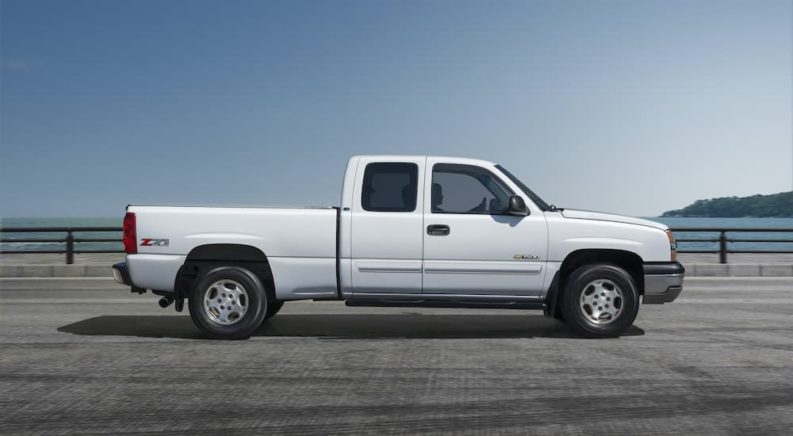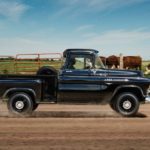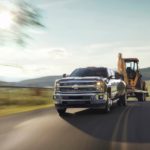Classic trucks are more than shiny vehicles you hide in your garage until it’s time to drive them to a car show. When using the term “classic,” it’s just a fancy word for used trucks that have been well-maintained so that they still look nice and run well even though they’re old. Plenty of people will argue otherwise, since there are classic truck owners who modify their trucks and restore them to be more powerful or to have nicer finishes than they did originally, but a classic truck is only special because it was saved from the salvage yard. However, that’s precisely why they are special, and it’s why some classic truck enthusiasts get so excited about certain brands or styles that survived the hard work and are still functional and easy on the eyes. Here, we’ll look at classic trucks with reliable engines that have survived the years.
#1 – Second Generation Dodge Ram
Back in 1994, Dodge drastically changed the Ram’s exterior design to radical appeal. Buyers converged on Dodge dealerships to get a new truck with the rounded hood and new fenders, which are still reflected in the trucks they build today, albeit under the Ram moniker. With sales exploding, large numbers of Dodge trucks were sold during this generation that lasted until 2001. The trucks found to be most capable and reliable were built with the famous Cummins diesel engine, a design that was kept very simple without lots of fancy new tech. Mechanical aspects of the engine were easy to work on, and they lasted for hundreds of thousands of miles with proper maintenance. Automatic transmissions tend to be the better choice than the manual in terms of wear and tear.
#2 – Ford F-Series 7.3-liter Powerstroke
Not to be confused with the new 7.3-liter Godzilla engine, the 7.3-liter Powerstroke engine was introduced for 1994 heavy-duty trucks in the Ford F-Series lineup and was available until 2003. Firstly, the Powerstroke is a diesel engine, and much like the Cummins diesel in the Ram, its appeal comes from its simplicity. Anyone who works on the Powerstroke will find that fewer moving parts means less repair and maintenance, and its iron block and head can withstand the pressure of serious hard work. This was an engine built for agricultural machines, and its capability is incredible for off-roading or towing to extreme measures. As diesel engines go, this is one of the most reliable ever designed. Expect to pile on the miles and keep on going well beyond the 200,000 mark on the odometer.
#3 – Supercharged Toyota Tacoma
Once upon a time, Toyota made it possible to order a Tacoma and have dealerships install a supercharger. In its first generation, Toyota saw an opportunity to address the issue of the truck’s underpowered four-cylinder and six-cylinder powertrains by offering TRD buyers an aftermarket supercharger to boost output. This supercharger could only be installed on the V6 engine starting in 1997 models, and then in 1998, Toyota added the option of a rear e-locker for off-roading. Unfortunately, early models from this generation were troubled by rust problems, but any model after the 2000 model year will make for an extremely reliable truck that has become a popular favorite of off-road enthusiasts. Superchargers were made available for Tacomas until 2016, when Toyota discontinued their availability.
#4 – Jeep Comanche
Between the two eras of the Gladiator, the Jeep Comanche rose to fill a gap in the lineup for truck fans. It first arrived in 1985 as a small truck built on the Cherokee platform, which means anyone who discovers one of these for sale can count on finding easily-interchangeable parts between the Comanche and Cherokee. One of the best versions of the Comanche was designed with the 4.0-liter straight-six engine with four-wheel drive and a short bed, making it another excellent off-roader. It also had a reliable engine that could handle over 250,000 miles, provided buyers avoid the transmission from Peugeot, which was used until 1989. The Comanche lasted in production until 1992, when it was replaced by the Dodge Dakota after Chrysler bought out Jeep’s then-owner, AMC. As an aside, a first or second-generation Dodge Dakota is another great option for compact truck lovers if you like the boxy design.
#5 – Chevy and GMC C/K Series
From 1988 to 2000, Chevy and GMC adopted the new GMT 400 platform for the last generation of the C/K series. With this new foundation, the C/K trucks also gained an independent front suspension that made them easier to steer and improved the ride quality. This particular choice by GM changed the light-duty truck segment, helping catapult pickup trucks to America’s vehicle of choice. The engine that offered some of the best capability in the lineup was the 5.7-liter small-block V8. Though this last generation of the C/K series became known as a sport truck made for street racing, they could also go off-road when modified with aftermarket parts which were available in plenty.
#6 – Ford F-150 SVT Lightning
Long before the new electric F-150 was even a twinkle in Ford’s Blue Oval eye, the SVT Lightning was designed as a street truck made to directly compete with Chevy street trucks that developed out of the former C/K trucks. When the SVT Lightning was introduced in 1993, it came with a modified 5.8-liter Windsor V8 small block tuned for high performance and was only offered with a regular cab with a short bed. The development of the Ford F-150 SVT Lightning meant a lot of customized features were designed exclusively for this limited-production truck. The suspension, in particular, was stiffened for the sport tuning, and it was dropped lower than the rest of the F-150 lineup to improve aerodynamics and responsiveness. A second generation came about in 1999 due to the SVT Lightning’s popular demand, with the truck now featuring a 5.4-liter supercharged Triton V8. This increased the capability so much that Ford broke records for the world’s fastest truck in 2003.
#7 – Nissan Hardbody
Yet another reliable, resilient compact truck finds its way into the hearts of those who fondly remember the 1980s, and this truck shared a platform with the Pathfinder that followed later. Starting halfway through 1986, Nissan began offering a redesigned version of the small truck powered with either a four-cylinder or six-cylinder engine that could run for a long time, as evidenced by the large numbers of Hardbody trucks still floating around the marketplace. What came just prior to the Hardbody was Nissan’s well-loved 720, which was produced for several years before Nissan shifted the design. During the years between 1986 and 1989, the Hardbody was built with a 3.0-liter V6 that boasted best-in-class horsepower for its day. Beyond the engine, the Hardbody earned its name due to the double-walled bed and rigid, straight-lined styling that was well-nigh indestructible.
#8 – Toyota Hilux
If you’re a fan of the original Back to the Future movie with Michael J. Fox, you might have been just as enamored of Marty McFly’s truck, which has become as legendary as the movie’s Delorean. Though Toyota officially retired the Hilux name from its US lineup in the mid-1970s, it held onto that name in the rest of the world. Besides being a drool-worthy object of Marty’s desire, the Hilux was also the forebear of the Toyota 4Runner, which has an expected lifespan of 25 years. In 1979, the Hilux was the first to bring four-wheel drive to the compact truck segment, and thus the off-roading culture of Toyota trucks was begun. Under the hood starting in 1979 could be found a 2.2-liter inline-four diesel engine, but it was only available with the long bed. High ground clearance, a torsion bar suspension, wide fender flares, and their noteworthy reliability were just a few of their high points during this exceptional era of Toyota compact trucks.




